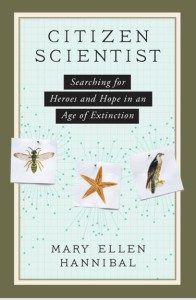January 2017 Blog Post: How to get involved with citizen science in the Bay Area
 As any addict of an activity tracker like Fitbit knows – if you can’t measure it, you can’t manage it. And that’s just what citizen scientists are trying to do! In this month’s blog post, Mary Ellen Hannibal, author of Citizen Scientist: Searching for Heroes and Hope in an Age of Extinction, highlights ordinary people contributing to scientific research by collecting and sharing local ecological data. Which types of projects will allow citizen scientists to be most effective? And how can you help out with the research?
As any addict of an activity tracker like Fitbit knows – if you can’t measure it, you can’t manage it. And that’s just what citizen scientists are trying to do! In this month’s blog post, Mary Ellen Hannibal, author of Citizen Scientist: Searching for Heroes and Hope in an Age of Extinction, highlights ordinary people contributing to scientific research by collecting and sharing local ecological data. Which types of projects will allow citizen scientists to be most effective? And how can you help out with the research?
Citizen science is regular people contributing to scientific research. It’s an ancient practice. Indigenous people the world over garner and apply “traditional ecological knowledge,” for example. Charles Darwin was a citizen scientist – he had no advanced degree and worked for himself. Today citizen science is turbo-charged by computing power, the internet, and smartphone technology. Citizen science can be used to identify galaxies, but I’m mostly concerned with biodiversity-focused efforts to save nature, which is under siege.
I first grokked the magnitude of the problem while researching my 2009 book (with the photographer Susan Middleton), Evidence of Evolution. Interviewing scientists about how life begins I got an earful about how it is prematurely ending. Mass extinction? Why? How? To investigate, I reported my subsequent book, The Spine of the Continent, which tells the creation story of a new science, conservation biology. Conservation biology figures out how nature works and what it needs to persist.
I don’t know which journalists like better, problems or solutions, but we do look for both. To the problem of extinction came the solution, conservation biology. But the solution, I realized, is not actually working to save nature. Nonprofits, academics, and do-gooders galore are sweating it out and trying their best – but biodiversity is still evaporating. The 2016 Living Planet Report of the World Wildlife Fund estimates that since 1970, the Earth has lost 58 percent of its vertebrate populations. What could scale to the level necessary to actually deal with this disaster?
As those of you addicted to the Fitbit know, if you can’t measure it, you can’t manage it, and this applies to saving nature. Currently, we do not have exact information about where nature is and in what amounts at any given time. Citizen science allows people with smartphones or even with a pencil and a piece of paper to tally up nature’s instances, as in a single observation of a bird or a bee, and to contribute it to a database. Individual observations add up to big pictures and allow us to track where nature is doing well and where it is declining. This focuses conservation efforts. People who do citizen science are likely to become involved in protecting the objects of their gaze.
My book, Citizen Scientist: Searching for Heroes and Hope in an Age of Extinction, explains this burgeoning phenomenon. I’ve endeavored to contextualize how nature works by way of geology, climate, non-human species, and of course, Homo sapiens! So, is citizen science the solution? Not quite. We need communities of people to cohere around ecological issues, to use citizen science to document them, and to then pursue protection of nature with local, regional, state, and federal agencies. Citizen science needs organizations like the Women’s Environmental Network!
What can WEN members do?
Currently, citizen science projects fall into two big categories – huge, global, entirely virtual database driven efforts like eBird, and local, discrete, place-based efforts like the California Academy of Science’s tide pool monitoring in Half Moon Bay. To bump citizen science up a notch in efficacy, we need to connect these projects at the local, regional, and continental scales. The way to start that is locally – and WEN, with its distributed membership across all Bay Area counties, could become such a platform, pretty easily.
One way to envision this is to get together WEN members who would like to participate, and see what counties or regions of the Bay Area these folks are from. Then – say there are enough people from San Francisco and the North, East, and South Bays to make four distinct groups. Each group could align itself with a current project going on in its area, or start a new “project” on iNaturalist to document biodiversity in the county.
Let’s say people wanted to join projects that are ongoing at our signature mountains – Tam, Diablo, Hamilton, and for San Francisco, let’s say the Presidio. The WEN website could host links to each of these efforts so people could browse what’s going on in different regions and compare notes.
The critical parts of this are to take data using established and vetted protocols like iNaturalist, and to connect socially about the experience. Citizen science is a networking phenomenon that hasn’t quite taken advantage of its own capacity to help form communities of like-minded people – and the only way for us to really save nature is to join together to do it. I would be very happy to brainstorm more ideas and help them get going. WEN has an immense built-in capacity to do something that hasn’t been done before.
If that all sounds like too much to begin with, okay! There are many citizen science projects in the Bay Area for WEN members to get involved with individually – a database of offerings can be browsed on the California Naturalist website.
About this month’s guest writer
 Mary Ellen Hannibal is a long-time journalist focused on natural history and literature. Her most recent book, Citizen Scientist: Searching for Heroes and Hope in an Age of Extinction, was named one of 2016’s best non-fiction books by the San Francisco Chronicle. She is a recipient of the National Association of Science Writer’s Science and Society Award, among other honors, and is currently a Stanford media fellow. You can learn more about Mary Ellen in this month’s WEN Spotlight feature.
Mary Ellen Hannibal is a long-time journalist focused on natural history and literature. Her most recent book, Citizen Scientist: Searching for Heroes and Hope in an Age of Extinction, was named one of 2016’s best non-fiction books by the San Francisco Chronicle. She is a recipient of the National Association of Science Writer’s Science and Society Award, among other honors, and is currently a Stanford media fellow. You can learn more about Mary Ellen in this month’s WEN Spotlight feature.
